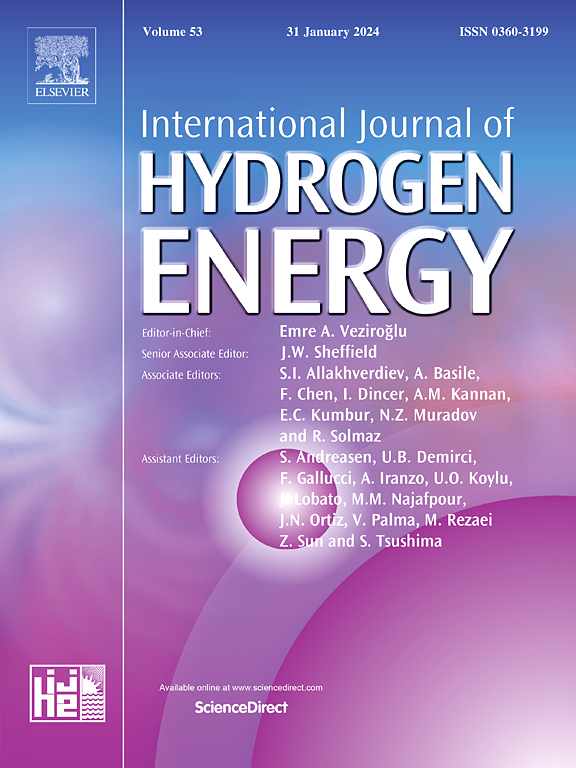用相场法研究不同孔隙度梯度配置的多孔输运层中氧的输运
IF 8.1
2区 工程技术
Q1 CHEMISTRY, PHYSICAL
引用次数: 0
摘要
在质子交换膜(PEM)电解槽中,减少多孔传输层(PTL)中的氧积累是降低传质损失的关键。采用相场法建立了PEM电解槽阳极气液两相流动的二维瞬态模型。该模型研究了PEM电解槽中氧的输运机制以及各种氧路径之间的相互作用。我们探索了PTL中孔隙度梯度配置和表面微孔层(MPL)的存在对氧传输的影响。研究结果表明,对于平均孔隙度为60%的PTL,正向梯度结构(孔隙度从催化剂层(CL)向通道(CH)增加)促进了气泡位点的合并和路径收缩,从而降低了氧饱和度。在最佳梯度配置下,低碳层的孔隙率为50%,低碳层的孔隙率为70%,氧饱和度降低了29.5%。相反,相反的梯度结构,从CL到CH孔隙度降低,导致氧饱和度增加。表面MPL的加入进一步降低了氧饱和度,缩短了破氧时间;MPL粒径越小,氧饱和度越低,突破时间越短。该研究为PEM电解槽PTL结构的优化设计提供了有价值的见解。本文章由计算机程序翻译,如有差异,请以英文原文为准。
Investigation of oxygen transport in porous transport layer with different porosity gradient configurations using phase field method
Minimizing oxygen accumulation in the porous transport layer (PTL) is crucial for reducing mass transfer losses in proton exchange membrane (PEM) electrolyzer. This study develops a two-dimensional transient model of gas-liquid two-phase flow at the anode of PEM electrolyzer using the phase field method. The model investigates the mechanisms of oxygen transport and the interactions among various oxygen paths in PEM electrolyzer. We explore the impact of porosity gradient configurations in the PTL and the presence of a surface microporous layer (MPL) on oxygen transport. The findings indicate that for PTL with an average porosity of 60%, forward gradient configuration—where porosity increases from the catalyst layer (CL) towards the channel (CH)—promotes the merging of bubble sites and path contraction, thereby reducing oxygen saturation. The optimal gradient configuration, with porosities of 50% at the CL and 70% at the CH, achieves a 29.5% reduction in oxygen saturation. Conversely, reverse gradient configuration, with decreasing porosity from CL to CH, results in increased oxygen saturation. The addition of surface MPL further lowers oxygen saturation and shortens oxygen breakthrough time; smaller MPL particle sizes correspond to lower oxygen saturation and shorter breakthrough times. This study provides valuable insights for the optimal design of PTL structures in PEM electrolyzers.
求助全文
通过发布文献求助,成功后即可免费获取论文全文。
去求助
来源期刊

International Journal of Hydrogen Energy
工程技术-环境科学
CiteScore
13.50
自引率
25.00%
发文量
3502
审稿时长
60 days
期刊介绍:
The objective of the International Journal of Hydrogen Energy is to facilitate the exchange of new ideas, technological advancements, and research findings in the field of Hydrogen Energy among scientists and engineers worldwide. This journal showcases original research, both analytical and experimental, covering various aspects of Hydrogen Energy. These include production, storage, transmission, utilization, enabling technologies, environmental impact, economic considerations, and global perspectives on hydrogen and its carriers such as NH3, CH4, alcohols, etc.
The utilization aspect encompasses various methods such as thermochemical (combustion), photochemical, electrochemical (fuel cells), and nuclear conversion of hydrogen, hydrogen isotopes, and hydrogen carriers into thermal, mechanical, and electrical energies. The applications of these energies can be found in transportation (including aerospace), industrial, commercial, and residential sectors.
 求助内容:
求助内容: 应助结果提醒方式:
应助结果提醒方式:


